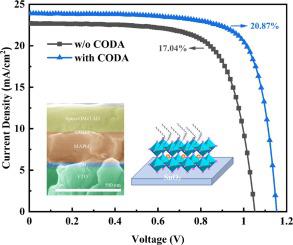Solar Energy ( IF 6.0 ) Pub Date : 2021-09-17 , DOI: 10.1016/j.solener.2021.09.032 Zhiying Feng , Zhetao Xia , Zhixing Wu , Yikun Hua , Guang Zhu , Xiaohong Chen , Sumei Huang

|
Nowadays, the photovoltaic (PV) performance of metal halide perovskite solar cells (PVSCs) is limited by defect state induced recombination at charge transport electrode/perovskite interfaces. These defects, most commonly under-coordinated lead and halide ions, have to be eliminated or passivated in order to promote the device efficiency towards its theoretical limit. In this work, a simple and effective passivation method is reported for PVSCs by employing cis-9-octadecenylamine (CODA), a frequently-used organic surfactant. The CODA passivation layer is positioned between the perovskite absorber and hole transport layer (HTL). The passivated layer is deposited by a spin-coating method and modulated by changing the CODA concentration. We find that the amine ligands on the CODA surfactant are likely to conduce to the distinguished passivation via forming coordination bonds with Pb2+ or I− ions, and hydrophobic connecting alkyl chain networks assembled on the top perovskite absorber surface also helps to resist penetration of humidity and hamper ion migration. CODA is able to efficiently reduce the charge trapping densities by passivating and/or decreasing of defects. Eventually, at an optimal CODA concentration, the perovskite absorbers that are amply passivated by CODA make the devices achieve a high open-circuit voltage (VOC) of 1.15 V and a champion efficiency of 20.87%. The resulting unpackaged device displays considerably enhanced ambient stability over 144 h while maintaining over 80% of its original efficiency under the relative humidity of 50% in the ambient air.
中文翻译:

通过有机表面活性剂界面钝化高效稳定的钙钛矿太阳能电池
如今,金属卤化物钙钛矿太阳能电池(PVSC)的光伏(PV)性能受到电荷传输电极/钙钛矿界面处缺陷态诱导复合的限制。这些缺陷,最常见的是配位不足的铅和卤离子,必须消除或钝化,以将器件效率提升到其理论极限。在这项工作中,报告了一种简单有效的 PVSC 钝化方法,通过使用顺式-9-十八碳烯胺 (CODA),一种常用的有机表面活性剂。CODA 钝化层位于钙钛矿吸收体和空穴传输层 (HTL) 之间。钝化层通过旋涂方法沉积,并通过改变 CODA 浓度进行调制。我们发现 CODA 表面活性剂上的胺配体可能通过与 Pb 2+或 I -形成配位键而有助于显着的钝化。离子,以及组装在顶部钙钛矿吸收体表面的疏水连接烷基链网络也有助于抵抗湿气的渗透并阻碍离子迁移。CODA 能够通过钝化和/或减少缺陷来有效地降低电荷俘获密度。最终,在最佳 CODA 浓度下,被 CODA 充分钝化的钙钛矿吸收体使器件实现1.15 V的高开路电压 ( V OC ) 和 20.87% 的冠军效率。由此产生的未封装器件在 144 小时内显示出显着增强的环境稳定性,同时在环境空气中 50% 的相对湿度下保持其原始效率的 80% 以上。











































 京公网安备 11010802027423号
京公网安备 11010802027423号